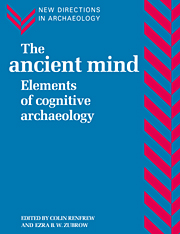Book contents
- Frontmatter
- Contents
- List of figures
- List of tables
- List of contributors
- Preface
- PART I INTRODUCTION
- PART II THE INTERDISCIPLINARY UNDERPINNING
- PART III APPROACHES TO CULT PRACTICE AND TRANSCENDENTAL BELIEF SYSTEMS
- PART IV PREHISTORIC CONCEPTIONS OF SPACE AND TIME
- PART V THE MATERIAL BASIS OF COGNITIVE INFERENCE: TECHNOLOGY
- PART VI THE MATERIAL BASIS OF COGNITIVE INFERENCE: WRITING SYSTEMS
- 16 Variation and change in symbol systems: case studies in Elamite cuneiform
- 17 Text and figure in ancient Mesopotamia: match and mismatch
- PART VII CONCLUSION
- Index
16 - Variation and change in symbol systems: case studies in Elamite cuneiform
Published online by Cambridge University Press: 03 December 2009
- Frontmatter
- Contents
- List of figures
- List of tables
- List of contributors
- Preface
- PART I INTRODUCTION
- PART II THE INTERDISCIPLINARY UNDERPINNING
- PART III APPROACHES TO CULT PRACTICE AND TRANSCENDENTAL BELIEF SYSTEMS
- PART IV PREHISTORIC CONCEPTIONS OF SPACE AND TIME
- PART V THE MATERIAL BASIS OF COGNITIVE INFERENCE: TECHNOLOGY
- PART VI THE MATERIAL BASIS OF COGNITIVE INFERENCE: WRITING SYSTEMS
- 16 Variation and change in symbol systems: case studies in Elamite cuneiform
- 17 Text and figure in ancient Mesopotamia: match and mismatch
- PART VII CONCLUSION
- Index
Summary
Archaeological study of cognitive systems
‘Cognition’ refers to the representation of knowledge and to the processes operating on those representations; a ‘cognitive archaeology’ would investigate aspects of knowledge representation and information processing which are recoverable from the archaeological record. This chapter is part of a workshop on the scientific directions which such investigations might take.
The workshop within which these discussions were pursued was mindful, in particular, of the past quarter century of efforts to improve the scientific grounding of archaeological reconstructions of past lifeways. The classics of this literature are applications of useful theoretical constructs, models of social/cultural processes being investigated, and hypothesis-testing using the empirical data provided by archaeology and often ethnography as well.
Three topical emphases distinguish such archaeological work from ethnography: the study of long-term change; the study of lifeways now extinct or now existing only in unrepresentatively restricted situations; the study of relationships between artefacts and behaviour. The archaeological study of cognitive systems has similar rationales. Each of these emphases is addressed by papers in this volume, and each affects the theoretical and methodological issues whose resolution is crucial to the use of archaeological material in coming to grips with past ways of understanding.
The contribution of this paper to the discussion is based on two premises:
- Cognitive processes and representations are not directly accessible. Because cognition mediates between experiencing an environment and acting in it, we obtain nonintrospective access to cognitive systems through the correspondences between environment and behaviour. This is our only access to it. […]
- Type
- Chapter
- Information
- The Ancient MindElements of Cognitive Archaeology, pp. 167 - 175Publisher: Cambridge University PressPrint publication year: 1994
- 3
- Cited by



